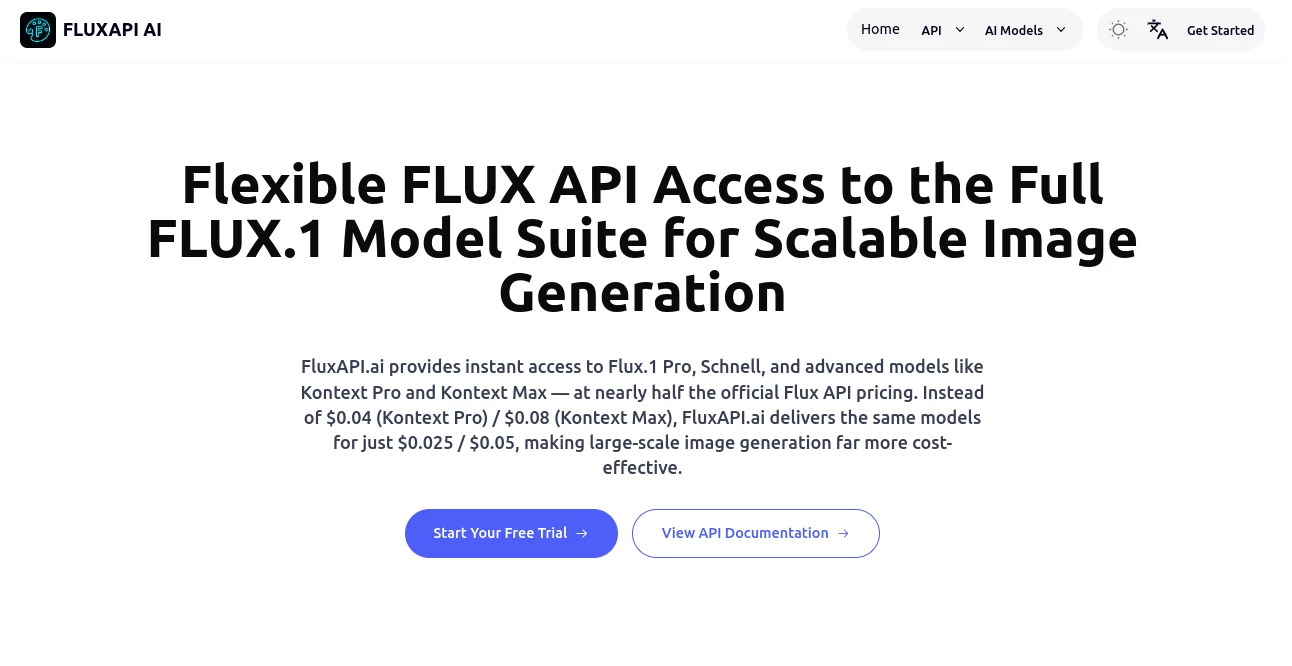FLUXAPI AI
Fast and Affordable Image Generation APIs

What is FLUXAPI AI?
FluxAPI delivers a straightforward way for developers to tap into powerful image creation tools, blending speed with savings in one seamless package. It stands out by wrapping advanced models into easy-to-call endpoints, letting builders craft visuals from descriptions or tweaks without the usual hefty tabs. Teams building apps or workflows often turn to it when they need reliable results that scale without breaking the bank, turning abstract ideas into crisp outputs in moments.
Introduction
FluxAPI emerged from the growing buzz around cutting-edge visual tech, where creators craved access without the gatekeeping. A small group of builders spotted the gap—strong models locked behind steep costs—and spun up this hub to democratize the process. It hit the ground running, pulling in folks from indie devs to larger outfits who wanted to weave dynamic images into their projects. Over time, feedback from early users shaped it into a lean machine, with stories circulating about prototypes that went from sketch to showcase overnight. What draws people in is its no-nonsense vibe: plug in, generate, and go, all while keeping things lighter on the wallet than the big players.
Key Features
User Interface
The dashboard keeps it simple, with a central playground for dragging files or typing prompts that updates live as you experiment. Tabs for keys and credits sit off to the side, easy to grab without hunting, and the trial area lets you swap ratios or formats with a quick pick. It's the kind of setup that feels familiar right away, like dipping into a well-worn notebook, and it plays nice on any screen size for on-the-fly tests during a coffee break.
Accuracy & Performance
Outputs land with a sharpness that captures the nuance of your input, holding details steady even in busy scenes. It zips through requests in seconds, thanks to tuned models that prioritize quick turns without skimping on quality, making it a solid pick for apps that can't afford lag. Builders note how it nails the intent behind vague descriptions, often needing just one pass to get something worth building on.
Capabilities
From spinning fresh scenes from words alone to refining uploads with targeted changes, it covers a broad canvas of visual tasks. Specialized options let you dial in speed for rough drafts or depth for final polish, supporting everything from single shots to chained edits across frames. It flexes for workflows like branding kits or storyboards, with endpoints that handle text guides or image bases seamlessly.
Security & Privacy
Keys get managed through a secure spot where you can swap them out in a flash if something feels off, using tokens that keep requests locked to your session. The trial mode offers a private toggle to keep experiments under wraps, and the whole flow avoids lingering data, giving you control without extra layers of worry. It's straightforward protection that lets you focus on creation rather than coverage.
Use Cases
App makers drop it into chat tools for on-demand visuals, letting users dream up scenes that pop up instantly. Designers prototype ad sets by tweaking styles across batches, speeding up client rounds without fresh shoots. Game devs layer in dynamic assets for levels, pulling from prompts that match the mood. Even educators build interactive slides, generating examples that illustrate points on the fly for engaging lessons.
Pros and Cons
Pros:
- Trims costs way down compared to similar setups, freeing up budget for other bits.
- Blends quick speeds with solid detail, ideal for real-time needs.
- Trial playground eases the jump in without upfront spends.
- Round-the-clock help keeps roadblocks short.
Cons:
- Credit packs mean watching tallies for big runs.
- Best on decent connections to avoid hiccups.
- Advanced chains might need a bit of scripting savvy.
Pricing Plans
It runs on a pay-as-you-go credit system, no lock-ins or baselines to bite you. Small bundles start cheap for testing waters, scaling to bulk buys that knock off a slice for loyalty. You kick off with free trial credits to poke around, then top up via card or quick pays, only charging for what you use. It's flexible enough for one-offs or steady streams, with no surprises lurking in the fine print.
How to Use FluxAPI
Sign in to snag your key from the management page, then load credits if you're past the trial. Head to the playground to test prompts or uploads, picking ratios and formats as you go. For code, slot the key into your calls with bearer setup, describe your scene, and pull the results. Tweak and retry from there, or hook it into your app for automated flows that run whenever needed.
Comparison with Similar Tools
Next to pricier gateways, this one slashes the per-image hit without dropping quality, though those might offer flashier dashboards for non-coders. Against open-source runners, it skips the setup grind for instant access, but tinkerers could prefer the full reins. It hits a sweet balance for teams wanting pro results on a shoestring, edging out the competition on value without skimping on the goods.
Conclusion
FluxAPI clears the path for visual innovation, handing developers the reins to build bold without the barriers. It turns the promise of smart generation into everyday reality, fueling projects that wow with ease and economy. As more apps lean on dynamic images, this spot keeps proving that great tools don't have to come with great costs, sparking creations that push the envelope one prompt at a time.
Frequently Asked Questions (FAQ)
How do I get my key set up?
Log in, hit the management tab, and copy it for your requests—swap anytime if needed.
What's the trial like?
Free credits let you test the playground fully, no card upfront.
Does it handle edits on my uploads?
Yes, guide changes with text or images for targeted tweaks.
Any limits on file types?
Sticks to common ones like PNG and JPG for smooth runs.
How's support handled?
Available around the clock for quick fixes or tips.
AI Text to Image , AI Photo & Image Generator , AI Image to Image , AI API Design .
These classifications represent its core capabilities and areas of application. For related tools, explore the linked categories above.
FLUXAPI AI details
This tool is no longer available; find alternatives on Alternative to FLUXAPI AI.
Pricing
- Free
Apps
- Web Tools
















